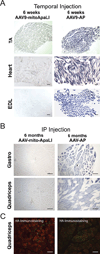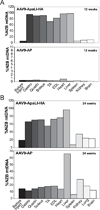Manipulation of mtDNA heteroplasmy in all striated muscles of newborn mice by AAV9-mediated delivery of a mitochondria-targeted restriction endonuclease
- PMID: 22130448
- PMCID: PMC3410960
- DOI: 10.1038/gt.2011.196
Manipulation of mtDNA heteroplasmy in all striated muscles of newborn mice by AAV9-mediated delivery of a mitochondria-targeted restriction endonuclease
Abstract
Mitochondrial diseases are frequently caused by heteroplasmic mitochondrial DNA (mtDNA) mutations. As these mutations express themselves only at high relative ratios, any approach able to manipulate mtDNA heteroplasmy can potentially be curative. In this study, we developed a system to manipulate mtDNA heteroplasmy in all skeletal muscles from neonate mice. We selected muscle because it is one of the most clinically affected tissues in mitochondrial disorders. A mitochondria-targeted restriction endonuclease (mito-ApaLI) expressed from AAV9 particles was delivered either by intraperitoneal or intravenous injection in neonate mice harboring two mtDNA haplotypes, only one of which was susceptible to ApaLI digestion. A single injection was able to elicit a predictable and marked change in mtDNA heteroplasmy in all striated muscles analyzed, including heart. No health problems or reduction in mtDNA levels were observed in treated mice, suggesting that this approach could have clinical applications for mitochondrial myopathies.
Figures





References
-
- Kyriakouli DS, Boesch P, Taylor RW, Lightowlers RN. Progress and prospects: gene therapy for mitochondrial DNA disease. Gene Ther. 2008;15:1017–1023. - PubMed
-
- Cwerman-Thibault H, Sahel JA, Corral-Debrinski M. Mitochondrial medicine: to a new era of gene therapy for mitochondrial DNA mutations. J Inherit Metab Dis. 2011;34:327–344. - PubMed
-
- Thorburn DR, Dahl HH. Mitochondrial disorders: genetics, counseling, prenatal diagnosis and reproductive options. Am J Med Genet. 2001;106:102–114. - PubMed
-
- DiMauro S, Schon EA. Mitochondrial respiratory-chain diseases. N Engl J Med. 2003;348:2656–2668. - PubMed
-
- Srivastava S, Moraes CT. Manipulating mitochondrial DNA heteroplasmy by a mitochondrially targeted restriction endonuclease. Hum Mol Genet. 2001;10:3093–3099. - PubMed
Publication types
MeSH terms
Substances
Grants and funding
LinkOut - more resources
Full Text Sources
Other Literature Sources
Research Materials

